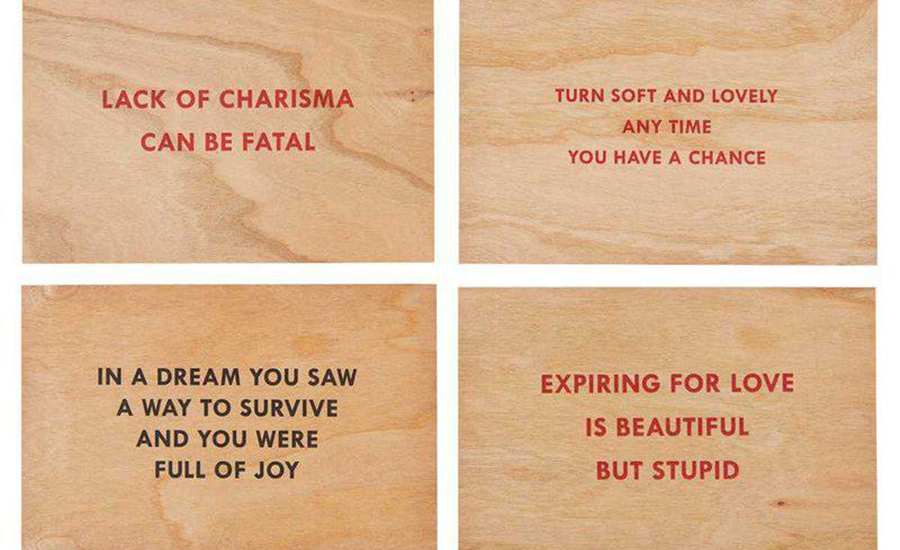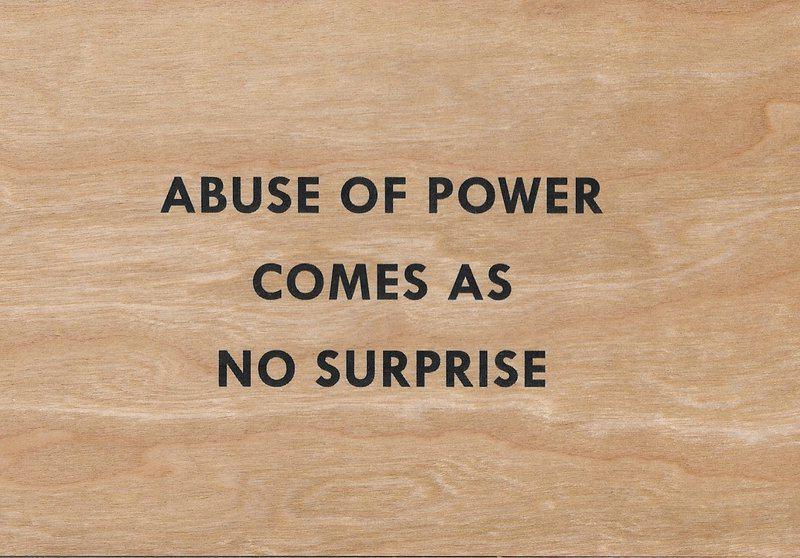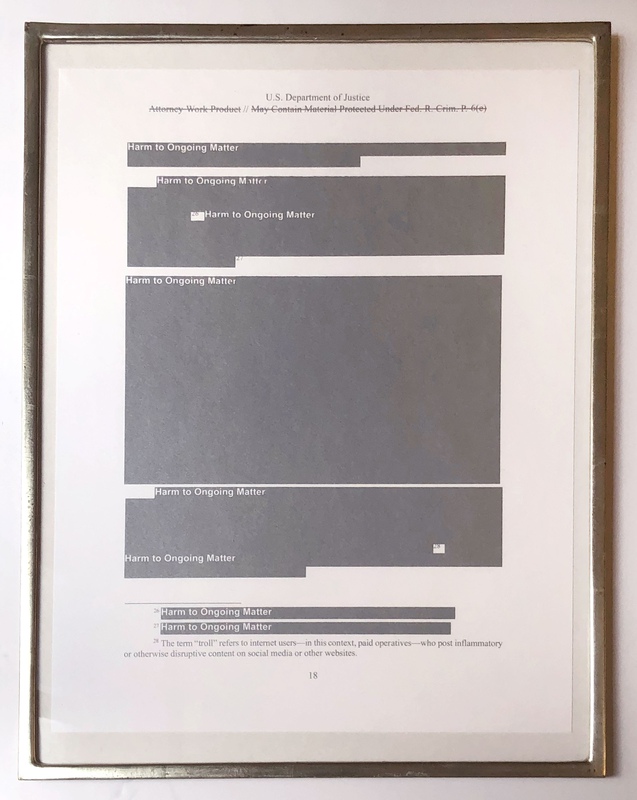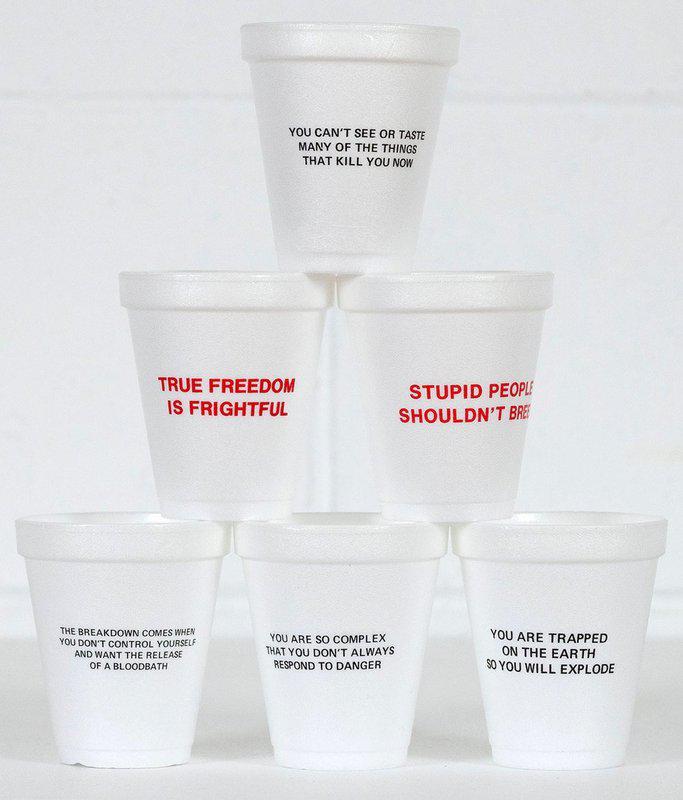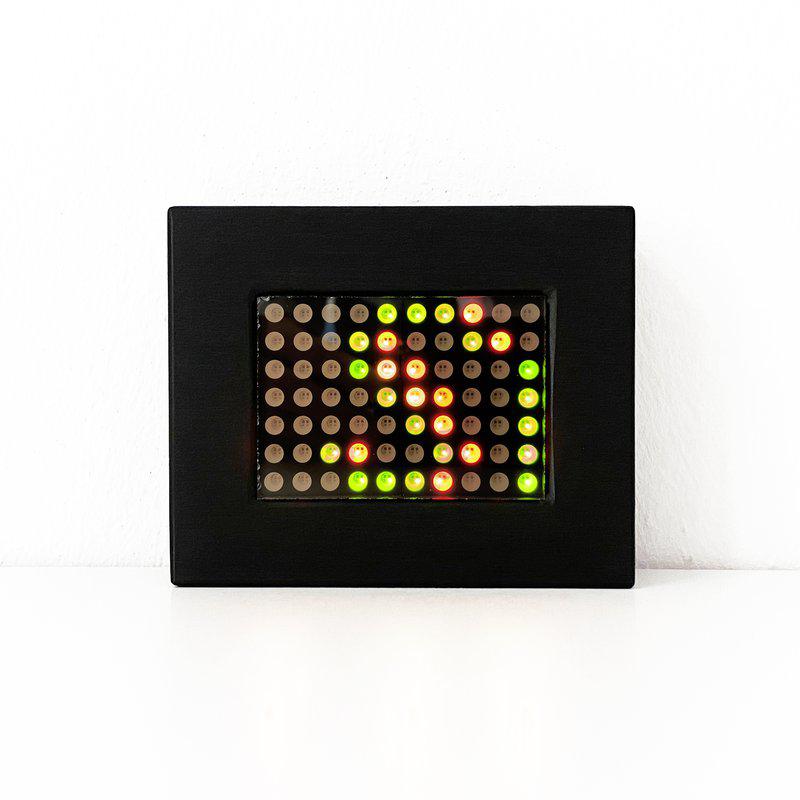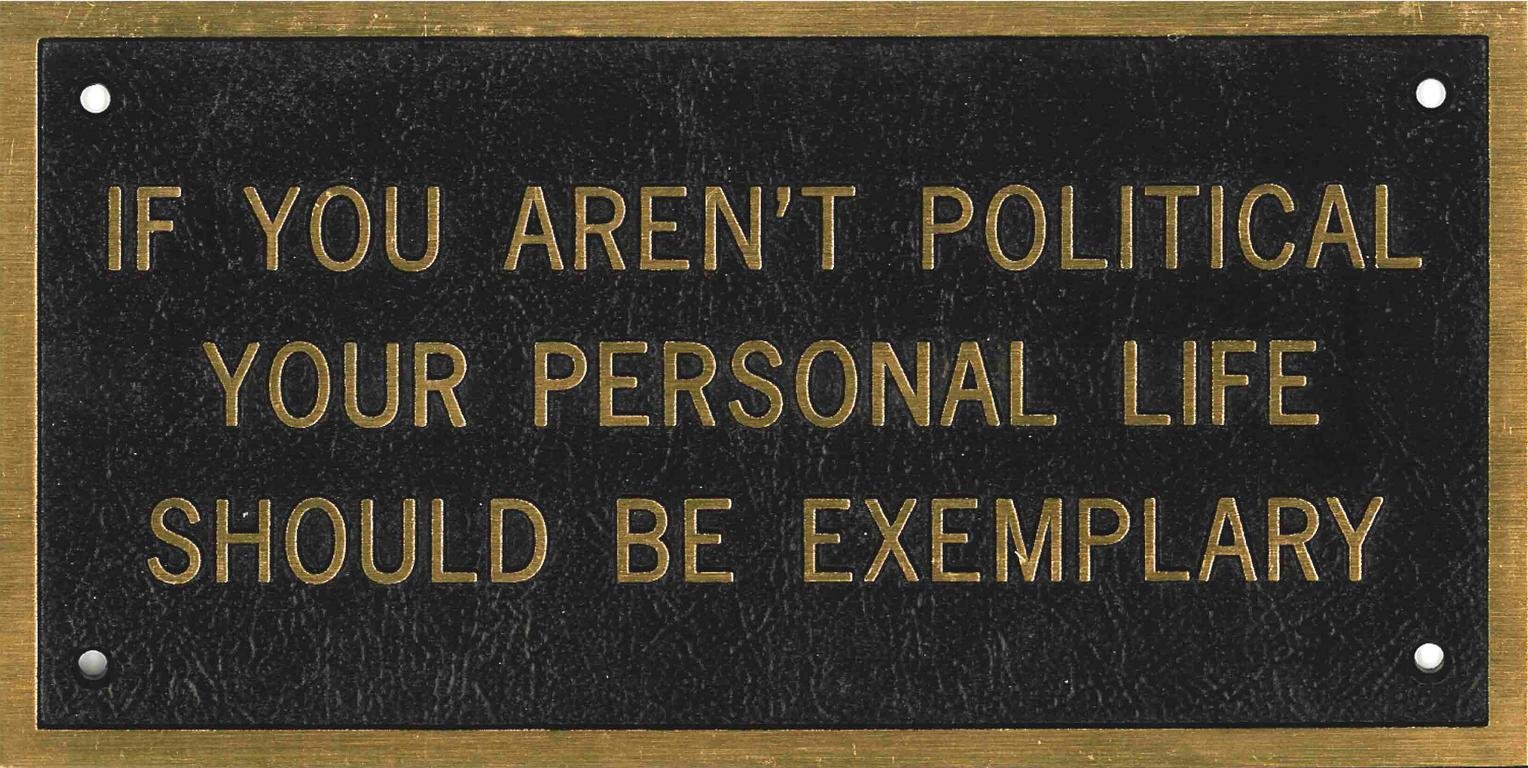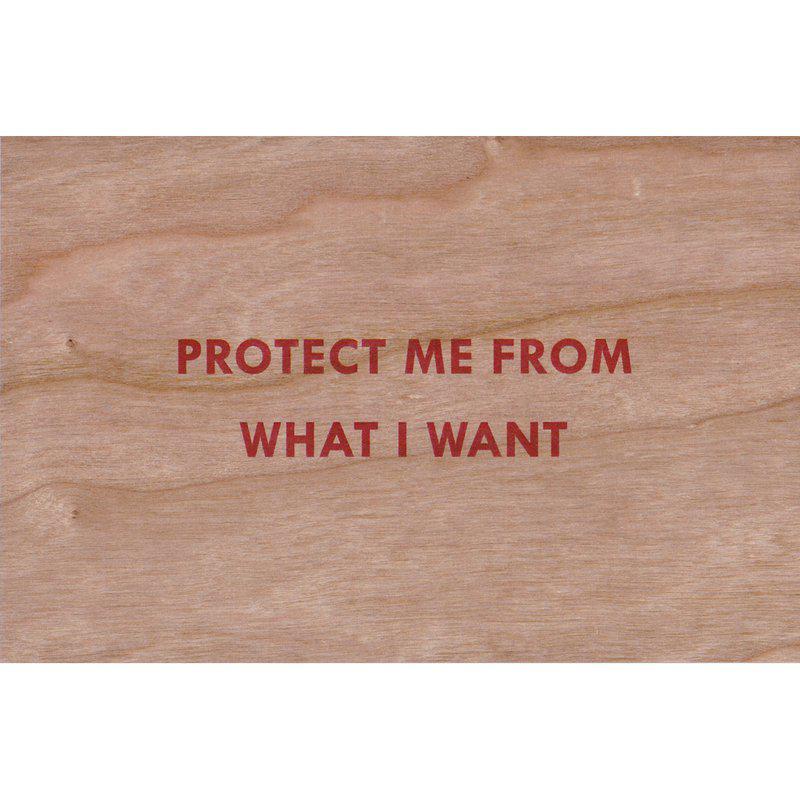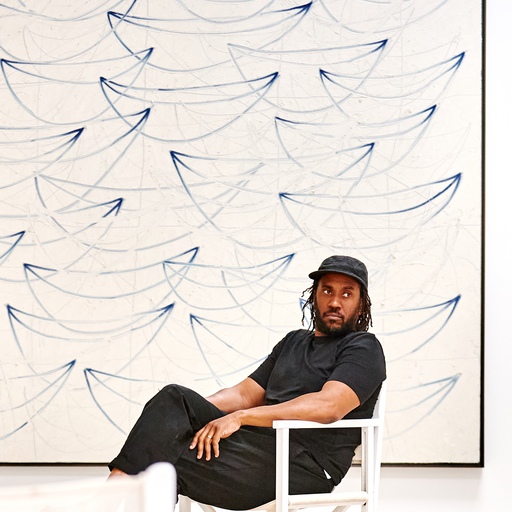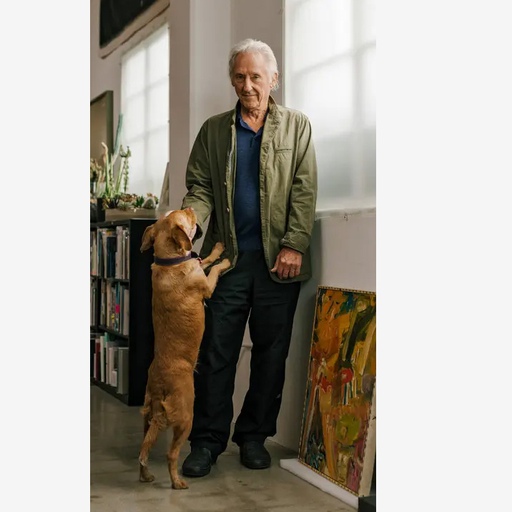In 2017, at the height of the #MeToo movement, a group of women sought to highlight sexual abuse in the art world. Rather than coin a new slogan, the group reached back forty years, to adapt a line created by the American conceptual artist Jenny Holzer that had never truly fallen out of style. The group called itself #NotSurprised, after one of the best-known entries in Holzer’s best-known work, her aphoristic one-liner text series, Truisms, which reads ‘Abuse of power comes as no surprise’.
You might be forgiven for thinking that the artworld slogans of the late 1970s, would have lost their potency four decades after their initial publication. However, Holzer’s diamond-hard prose has shown the same sort of staying power as a Renaissance masterpiece.
Jenny Holzer – Abuse of Power Comes as No Surprise , 2018
Jenny Holzer was born in Gallipolis, Ohio in 1950, in that town’s Holzer hospital. Her paternal grandparents, a doctor and a nurse, had founded the institution in the opening decades of the 20th century.
Holzer’s father, Richard or ‘Dick’ Holzer, owned a Ford dealership, while her mother, Virginia, was a nurturing parent, encouraging her daughter to read books borrowed from the library.
The young girl enjoyed classics such as Wuthering Heights by Emily Brontë, and attempted to write her own prose; Jenny also considered a career in law, before opting for fine art, studying first at Duke University in Durham, North Carolina, then at the University of Chicago before completing her BFA back in her home state, at Ohio University.
Jenny Holzer – Harm to Ongoing Matter , 2019
Once back home, Holzer took a clerical position in the claims department of Holzer hospital, and used discarded, error-ridden index cards from her day-job in an early work. “I pasted the cards on a panel in rows,” she later recalled. “I put them in lines, just had to organise rhythm into tight, neat rows. I didn’t show the piece to anybody.”
She did, however, continue to investigate artistic opportunities which lay beyond simple painting. Holzer signed up to the MFA course at the Rhode Island School of Design, created video works, installations and began to make works based on scientific diagrams, ultimately taking a stronger interest in the diagrammatical captions.
Moving to New York in 1976 to join the Whitney museum’s independent study programme, Holzer was impressed by faculty member Ron Clark’s knotty reading list, and attempted to rework some of the prescribed text’s key notions into one-liners “to see if these ideas — as contradictory as they could be — might be capable of stopping people in their tracks and having them muse over them,” as she later recalled.
Jenny Holzer – Brother- Inflammatory Essay, Steal, 1982
This became Truisms , which the artist continued to develop until 1979, printing selections of the lines from this series onto hand bills, which she pasted up in various locations around New York City.
She employed the same technique for a subsequent series, Inflammatory Essays (1979-82) – longer texts which Holzer printed onto a variety of different colored paper sheets, again pasting them up around NYC. She was even arrested during one of her unsanctioned pasting sessions, though eventually the police let her go, “I was dripping with so much wheat paste they probably didn’t want me on their back seat much longer,” the artist told the New York Times.
Jenny Holzer – Survival Cups , 1983
Fortunately, other display spaces had opened up. In the early 1980s Holzer gained both gallery representation, and the opportunity to show her text works in a wide variety of non-traditional settings. Texts by the artist were printed onto Styrofoam cups, wooden postcards, t-shirts and condom wrappers. In 1982 in her Messages to the Public show, Holzer had her text flashed up onto Times Square’s Spectacolor, animated-light sign. In her 1986 show, Under a Rock, she chose to have her words chiselled onto granite benches and flashed across LED signs. In the case of the former, this choice of so classical a material may seem odd, but Holzer had her reasons.
The show was staged in 1986, around the time the artist had left NYC and moved to the country. In her new, bucolic setting, she had decided that "rocks are pretty nice," she later explained. She also realised she’d need some kind of seating for spectators to sit on while they read her scrolling texts; and also, given the heightening tensions during this period in the Cold War, she decided granite was a material likely to survive a nuclear apocalypse. “I thought that I should put something on rock, so that after Armageddon, someone could overturn the stone and read,” she reasoned.
Jenny Holzer – Inflammatory Essays 3 , 2002
This balance between the momentary and the monumental continued throughout Holzer’s career. Though her works have been reworked and repurposed in many ways (Jodie Foster even played a Holzer-like artist in Dennis Hopper’s 1990 romantic action thriller, Catchfire ), Holzer has always responded to the tenor of the times.
Her Laments series (1988-89) was made during the AIDS epidemic; her War series (1992) responded to the first Gulf War. Lustmord (1993-94) meanwhile, was, in part, prompted by the conflict in Bosnia; while her more recent Redaction Paintings (2008), works based on declassified and partially redacted documents, was made partly in response to the war on terror.
Jenny Holzer – IF YOU AREN'T POLITICAL YOUR PERSONAL LIFE SHOULD BE EXEMPLARY , 1988
In 2016 she created one of her most powerful and moving works - the stone slabs carrying lines from Walt Whitman's Song of Myself for the New York City AIDS Memorial.
“My friend, the poet Henri Cole, made the welcome suggestion of 'Song of Myself'. Another friend, Nick Morgan, and I cut the poem slightly to fit the site, the times and the purpose,” she told Phaidon.com at the time.
"'Song' has love, and lovely words overflowing, and represents ardent unashamed people abounding, people of all sorts, and that is how and what the memorial must be.” That same year, at the invitation of Cirque du Soleil founder Guy Laliberté, the artist had excerpts from the modernist poet Hilda Doolittle’s work etched onto rocks in Ibiza.

Portrait of Jenny Holzer by Nanda Lanfranco - image courtesy the artist
September 2022, following the attempted murder of author Salman Rushdie by an Islamic extremist called Hadi Matar, Holzer partnered with PEN America to project a series of texts from a wide range of writers, including Margaret Atwood, J.K. Rowling, and Toni Morrison, onto the façades of 30 Rockefeller Plaza, 610 Fifth Avenue and 620 Fifth Avenue in Manhattan.
Holzer had stopped composing her own texts in 2001, choosing instead to draw on works written by a wide range of other writers. While this may appear to be a strange move for an artist so closely associated with the production of words, Holzer has always distanced herself from an authorial position. As the American art historian David Joselit put it in the artist's 1998 Phaidon monograph, “the ‘author’ projected by Holzer’s texts is nowhere and everywhere – both uncannily personal and rigidly ideological. There’s that shock: what is this, who’s saying this, where’s it coming from, what does it mean to me?”
To see more of Jenny Holzer's work, take a look at her artist page on Artspace.











